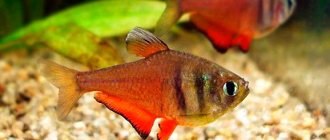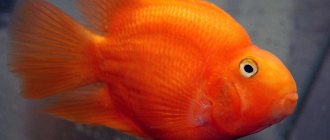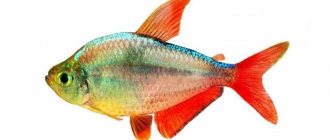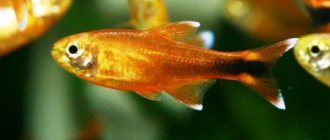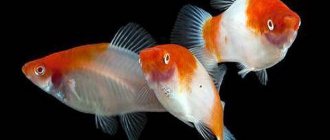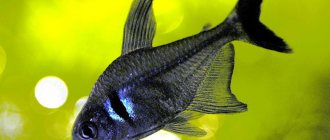Diamond tetra (Moenkhausia pittieri) belongs to the genus Moenkhausia, family Characidae. The genus includes about fifty species of fish, quite different in appearance, but with a predominance of silver-steel colors in color. The species was first described by the naturalist Egeinmann in 1920 and 10 years later it was firmly established in amateur aquariums. In everyday life, fish from this and some other genera are called tetras. All these species are united by a well-marked lateral line and small scales on the caudal fin. The genus Moenkausia is represented in aquariums by a dozen species. One of which is diamond tetra.
Habitat in nature
The diamond tetra (Moenkhausia pittieri) was first described by Karl Eigenmann in 1920. Although the word pittieri in the fish's name has not been identified, it was probably derived from the Swiss-born geographer-botanist Henri François Pittier de Fabregues.
Moenkhausia pittieri lives in South America. Diamond tetras are endemic to northern Venezuela. They come from Lake Valencia, located between the states of Carabobo and Aragua, and its tributaries. Lake Valencia is located between two mountain ranges and is the second largest lake in Venezuela. Water quality is generally very poor, mainly due to pollution from human agricultural and industrial activities. Scientific studies have shown that fish species diversity declined by almost 60% in the mid- to late-twentieth century. Today the species appears to have completely disappeared from Lake Valencia, where they originally lived.
They prefer calm waters of lakes or slowly flowing tributaries, with abundant plants on the bottom. They swim in schools, feed on insects that have fallen on the water and those living in the water.
Reproduction
Breeding these fish is made a little more difficult by the fact that they are not livebearers. And since spawning can occur in a community aquarium, this can be fraught with dire consequences: the eggs will either disappear or be eaten by other representatives of the aquarium. Therefore, to prevent this from happening, it is better to place the determined pair in a separate aquarium, with a volume of 10-15 liters.
Fill it with water from a community aquarium and add some fresh, settled water; the pair is usually kept there for 2-3 weeks, they are well fed and not disturbed by excessive attention.
Over time, the water temperature When the eggs have already been laid on the bottom of the aquarium, it is better to place a net so that hungry parents do not eat their offspring. No special lighting is required during this period; a small amount of light coming from the window will be enough.
Although the female lays up to 400 eggs on average, some of them still remain unfertilized. The male and female are removed to the main aquarium, and meanwhile the babies gain strength.
For the first few days, the fry lie at the bottom of the hatchery or stick to its walls, and only after 6 days will they begin to gradually eat food (ciliates or live dust). And after 6-7 months, these offspring will be ready for mating.
Description
The diamond tetra is quite large compared to other tetras. It grows up to 6 cm in length, which is relatively large. Life expectancy in an aquarium is about 5 years.
The diamond tetra has large scales with a green and gold tint, giving it a sparkling appearance in the water, which is how it got its name. But coloration develops only in mature fish, and juveniles are rather pale in color.
Tetragonopterus
•
•
Tetragonopterus
Tetragonopterus
found in the La Plata River.
They were first brought to Europe in 1922; they were widespread here until 1941 and have survived to this day. In aquariums, Tetragonopterus
usually reaches 5-6 cm in length, sometimes 12 centimeters.
The main color of Tetragonopterus is yellowish-brown with a metallic sheen; the belly is silvery. From the middle of the caudal peduncle to the end of it, a black stripe stretches along the lateral line, expanding into a diamond-shaped spot at the base of the caudal fin. All fins, except the pectoral ones, are colored red, more intense in the anal one.
The iris of the eyes is red in the upper half. Conditions for keeping and feeding Tetragonopterus
simple. The water temperature in the aquarium can vary from 12 to 25° (preferably 18-24°). In addition to food of animal origin, plant-based foods are also desirable. Tetragonopterus are not demanding on the pH of the environment, hardness and freshness of water.
Obtaining offspring is easy. Tap water is usually used. Fish are bred in large frame aquariums with a bottom area of 2000 cm2 and a water layer of 25-35 cm. A pinnate bush, several sagittaria bushes, and small-leaved plants covering the bottom are used as a substrate. You can do without plants.
The larvae hatch after 24 hours, and after four days they turn into fry, begin to swim and feed on ciliates, nauplii and finely crushed lettuce leaves, and later on small cyclops.
The Latin name of the fish is hemigrammus caudovittatus.
COMMENTS ON THE TOPIC
Reef fish:
• butterflies• triggerfish• angels• moray eels• clowns• surgeons• dogs
Freshwater fish:
• guppies• discus• catfish• gourami• angelfish• cockerels• rasboras• goldfish online diagnosis of diseases, symptoms in fish, drugs for treatment
Snails, crabs, crayfish, shrimp, chameleons, newts
Glued aquarium, denitrifier, DIY aquascape, aquarium first aid kit, water softening, leaking aquarium
INTERESTING TO READ
Erythrosonus
Erythrozonus
comes from the forest reservoirs of Western Guiana.
This fish was first brought to Europe in 1939, and to us in 1957. Females reach 4.5 cm in length, males are usually smaller. The color of the translucent body of Erythrosonus
is yellowish, turning white on the abdomen. From the head...
Hemigrammus
The genus
hemigrammus
is very close to the genus Hifessobricon. Representatives of this genus can be distinguished from the latter by the presence of scales on the body near the caudal fin. The recommended housing and feeding conditions are the same as for the Hifessobricon genus, but, as a rule,…
From the editor: The most unpretentious aquarium fish
Content complexity
It is quite easy to maintain, especially if you have some experience in keeping characins. Since it is quite popular, it is bred en masse, which means it is adapted to different conditions and water parameters.
Another thing they love her for is that she is quite unpretentious. For maintenance you need a spacious aquarium with soft water and dim lighting, preferably dimmed with the help of floating plants.
These are peaceful but very active fish. They move all the time and are always hungry, and when they are hungry they can pick off tender plants. But, if you feed them food with a high content of plant components, they will leave the plants alone.
Sexual Dimorphism
Males are slightly larger and less plump than females, with a greater proportion of reflective scales. When mature, they have elongated ventral, dorsal and anal fins. Males have a rich purple tint, while in females it is almost invisible.
Capable of reproduction at 8-12 months.
Feeding
Omnivores, diamond tetras eat all types of live, frozen or artificial foods. In the wild, they eat whatever they can get, with a preference for small insects, especially mosquito larvae.
The basis of nutrition can be flakes, and additionally feed them with live or frozen food - bloodworms, brine shrimp. Since they can damage plants, it is recommended to add plant foods to the menu, such as spinach leaves or flakes containing plant food.
For keeping Erythrosonus - firefly tetra, compliance with these conditions may be less strict!
It is enough to maintain the pH at 7.0 and gH to 10-12. The fish is schooling, mobile, active when feeding (only the food should be small enough - the fish has a small mouth). Other sized tetras (various neons, other small hifessobricones and chemigrammus) are quite suitable for company; among other soft-water fish with erythrozonus, you can keep small armored corydoras catfish, as well as small American and African carptooths; small barbs...
But keep in mind that Erythrosonus (like most fish in this area of South America) tolerates some increase in nitrites and nitrates well, but does not tolerate large amounts of fresh water when changing it! It is better to replace in small portions, but more often...
Feeding aquarium fish should be correct: balanced, varied. This fundamental rule is the key to the successful keeping of any fish, be it guppies or astronotuses. The article “How and how much to feed aquarium fish” talks about this in detail; it outlines the basic principles of the diet and feeding regime of the fish.
In this article, we note the most important thing - feeding fish should not be monotonous; the diet should include both dry food and live food. In addition, you need to take into account the gastronomic preferences of a particular fish and, depending on this, include in its diet food either with the highest protein content or, conversely, with plant ingredients.
It should be noted that when purchasing any dry food, you should pay attention to the date of its manufacture and shelf life, try not to buy food in bulk, and also store food in a closed state - this will help avoid the development of pathogenic flora in it
Keeping in an aquarium
For maintenance you need an aquarium of 70 liters or more; if you are counting on a large school, then a larger one is better, since the fish is very active. Like all tetras, diamond ones live in flocks, and you need to keep at least 7 individuals, or preferably more. A hierarchy is formed in the school, aggression within the species is distributed among all fish (although the diamond tetra is not aggressive), the behavior of fish in the school is more interesting and natural.
And so, she is quite picky and adapts to most conditions. Diamonds do not like bright lighting; it is advisable to shade the aquarium. Moreover, in such an aquarium they look their best.
The diamond tetra looks best in the Amazonian biotope. Use a river sand substrate and add some driftwood (beech is safe to use as long as it is thoroughly dried and stripped of bark) and twisted roots. A few handfuls of dried leaves (again, beech or oak leaves can be used) will complete the natural feel. Allow the wood and leaves to turn the water the color of weak tea by removing old leaves and replacing them every few weeks to prevent them from rotting and contaminating the water. In such an environment, the lighting should be quite dim.
Regular water changes, up to 25%, and filtration are required. Water parameters may be different, but the optimal ones will be: temperature 23-28 ° C, pH: 5.5-7.5, 2 - 15 dGH.
BREEDING
The diamond tetra reproduces in the same way as many other tetra species. A separate aquarium, with dim lighting, it is advisable to close the front glass altogether. You need to add plants with very small leaves, such as Java moss, on which the fish will lay their eggs. Or, cover the bottom of the aquarium with a net, as tetras can eat their own eggs. The cells must be large enough for the eggs to pass through.
The water in the spawning tank should be soft with an acidity of pH 5.5-6.5 and a hardness of gH of 1-5. Diamond tetras can spawn in a school, and a dozen fish of both sexes is a good option. Breeders are fed with live food for a couple of weeks before spawning; it is also advisable to keep them separately. With such a diet, the females will quickly become heavy with eggs, and the males will gain their best coloring and can be moved to the spawning area. Spawning begins the next morning. To prevent the spawners from eating the eggs, it is better to use a net, or remove them immediately after spawning. The larva will hatch in 24-36 hours, and the fry will swim in 3-4 days. From this moment you need to start feeding it, the primary food is ciliates, or food of this type; as the fry grows, you can transfer the fry to Artemia naupilia.
Compatibility
Not aggressive, schooling fish. Most characins are suitable for keeping, including neons, rhodostomus and red neons. Due to the fact that the diamond tetra has long fins, it is worth avoiding fish that can pluck them, such as Sumatran barbs or tetragonopterus.
